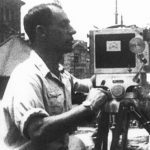 History
History  History
History  Weird Stuff
Weird Stuff 10 Superstitious Beliefs That Once Consumed Entire Cultures
 History
History 10 Bizarre Friendly Fire Incidents in Military History
 Technology
Technology 10 Modern Technologies That Accidentally Imitate Ancient Magic
 Mysteries
Mysteries 10 Mysteries of the Human Genome
 Weird Stuff
Weird Stuff 10 Things So Rare They’ve Only Been Found Once
 History
History 10 Legends Whose Last Moments Undid Their Glory
 Health
Health 10 Futuristic Ideas to Treat Common Medical Problems
 Weird Stuff
Weird Stuff Ten Surreal Attempts to Reverse Baldness
 Facts
Facts 10 U.S. Government Contingency Plans for the Unthinkable
 History
History 10 Odd Things Colonial Americans Kept at Home
 Weird Stuff
Weird Stuff 10 Superstitious Beliefs That Once Consumed Entire Cultures
 History
History 10 Bizarre Friendly Fire Incidents in Military History
Who's Behind Listverse?

Jamie Frater
Head Editor
Jamie founded Listverse due to an insatiable desire to share fascinating, obscure, and bizarre facts. He has been a guest speaker on numerous national radio and television stations and is a five time published author.
More About Us Technology
Technology 10 Modern Technologies That Accidentally Imitate Ancient Magic
 Mysteries
Mysteries 10 Mysteries of the Human Genome
 Weird Stuff
Weird Stuff 10 Things So Rare They’ve Only Been Found Once
 History
History 10 Legends Whose Last Moments Undid Their Glory
 Health
Health 10 Futuristic Ideas to Treat Common Medical Problems
 Weird Stuff
Weird Stuff Ten Surreal Attempts to Reverse Baldness
 Facts
Facts 10 U.S. Government Contingency Plans for the Unthinkable
10 Forgotten American Pastimes and Hobbies
As times change, so do the ways people spend their leisure time. The hobbies and pastimes that once defined American culture often fade into history, replaced by new forms of entertainment. From activities born out of necessity to quirky trends that captivated entire generations, these forgotten pastimes offer a fascinating glimpse into how Americans lived, worked, and played in the past.
Here are 10 American hobbies and pastimes that have fallen out of favor, but each tells a unique story about the eras that embraced them.
Related: 10 Strange Hobbies You Could Be A Champion At
10 Victorian-Era Shell Art
In the late 19th century, Americans were swept up in the Victorian trend of crafting intricate shell art, a pastime that blended creativity with natural elements. Women collected seashells during seaside vacations, turning them into elaborate decorative pieces like picture frames, jewelry boxes, wall hangings, and even small furniture accents. This hobby was seen as a way to showcase both artistic skill and an appreciation for nature, aligning with the Victorian values of beauty and refinement.
Magazines and how-to guides provided detailed instructions for crafting with shells, encouraging women to incorporate their own unique designs. Wealthy households often displayed these creations as symbols of sophistication, while working-class families saw it as an affordable way to create keepsakes.
Some of the most elaborate shell art creations were displayed at state fairs or local exhibitions. While the trend began to fade with the advent of mass-produced decor in the early 20th century, it laid the groundwork for modern crafts involving natural materials.[1]
9 Soap Carving Competitions
During the 1920s and 1930s, soap carving became a nationwide craze, particularly popular with children and young adults. This accessible hobby allowed participants to transform a humble bar of soap into intricate sculptures, ranging from animals to architectural miniatures. Companies like Ivory Soap capitalized on the trend, releasing instructional booklets and sponsoring national soap carving contests. These competitions often attracted thousands of participants, with winners receiving prizes ranging from cash to scholarships.
Schools also embraced soap carving as an educational tool, incorporating it into art classes to teach precision and patience. During the Great Depression, it became a beloved activity for families who couldn’t afford expensive hobbies. Newspapers frequently featured photos of soap carving champions alongside their intricate creations.
By the mid-20th century, however, soap carving declined as plastics and other materials became more common in crafting. Today, it’s remembered as a nostalgic pastime that brought art into everyday life.[2]
8 Darning Socks
Darning socks was once a staple of American life, blending necessity with a communal, meditative hobby. For much of the 19th and early 20th centuries, families couldn’t afford to replace socks every time they wore out. Instead, they relied on darning—a technique using a needle and thread to repair holes. Special tools like darning eggs or mushrooms were used to stretch the fabric, ensuring an even stitch.
Darning often became a shared family activity, particularly in rural areas where evenings were spent mending clothes by lamplight. Children were taught the skill early, and some even competed to see who could create the neatest or strongest repair.
During World War II, the government encouraged darning as part of resource conservation efforts. However, the post-war boom in affordable, mass-produced clothing made repairing socks less practical, and the practice began to fade. While it has seen a small revival among sustainability advocates, it is no longer a mainstream pastime.[3]
7 Sunday Afternoon Band Concerts in the Park
In the late 19th and early 20th centuries, band concerts were the highlight of Sunday afternoons in towns and cities across America. Brass bands performed in public parks, drawing large crowds who came to enjoy patriotic marches, light classical music, and popular songs of the day. These events were more than just entertainment; they were social gatherings that brought communities together. Families would pack picnic baskets, couples would stroll arm in arm, and children would run around the park while the band played on.
Some towns even had rival bands competing for the largest audiences, and municipalities took pride in funding and maintaining their local groups. These concerts often coincided with holidays or special events, adding an extra layer of festivity. However, with the rise of radio and recorded music in the 1920s, live band concerts began to decline. Today, while summer music events still exist in some communities, the tradition of weekly band concerts as a communal pastime has largely disappeared.[4]
6 Cigarette Card Collecting
Cigarette cards, which originated as stiffeners to protect cigarette packs, became an unexpected cultural phenomenon in the late 19th and early 20th centuries. These small collectible cards featured colorful illustrations of celebrities, exotic animals, famous athletes, historical events, and even how-to guides for magic tricks or gardening. Collectors, both young and old, eagerly traded cards to complete themed sets, with companies releasing new designs regularly to keep the public engaged.
The hobby reached its peak in the 1910s when collectors’ albums were sold to house full sets of cards. Some cards became highly sought-after, with rare editions fetching significant sums even then. As health concerns about smoking grew and advertising regulations changed in the mid-20th century, cigarette companies stopped including cards in their packaging. While vintage cards are now valuable collector’s items, the widespread excitement over trading and collecting them has largely faded.[5]
5 Homemade Radio Building
Homemade radio building was a beloved pastime in the early 20th century, especially during the 1920s and 1930s when radio technology was still a marvel. Enthusiasts purchased kits or scavenged parts to assemble their own radios, learning about electronics and broadcasting in the process. Tinkering with different designs and antenna placements became an obsession for many, and families often gathered around homemade sets to listen to news, music, and entertainment.
Radio building was also a gateway to the burgeoning world of ham radio, where amateurs communicated with others across long distances. During the Great Depression, this hobby was especially popular because it provided a relatively cheap entertainment and connection. By the mid-century, the advent of affordable, factory-made radios and televisions led to a decline in DIY radio building. However, it remains a niche interest among hobbyists today.[6]
4 Quilting Bees
Quilting bees were more than just a way to create bedding—they were social lifelines for rural and frontier communities in 19th-century America. Women gathered in groups to collaborate on large quilting projects, turning what could have been solitary labor into an opportunity for camaraderie and support. These gatherings often lasted all day, with participants sharing meals, stories, and local news as they worked.
Quilts created at these events were often imbued with sentimental value, incorporating scraps of fabric from old clothes or mementos of loved ones. Some quilting bees were held to mark significant life events, like weddings or births, making the quilts symbols of community and memory.
As industrialization brought cheap, store-bought bedding, quilting bees became less common. While quilting remains a popular craft, the communal gatherings that defined the tradition are now rare, replaced by individual projects and online communities.[7]
3 Icebox Racing
Icebox racing, a quirky and inventive pastime, emerged in the 1950s and 1960s as a playful way for small-town Americans to repurpose outdated appliances. Participants transformed old wooden iceboxes into makeshift downhill carts and raced them on local hills, much like the more formalized soapbox derbies. These events were often lighthearted affairs, with contestants decorating their iceboxes with paint, flags, and other embellishments.
Community involvement was key, with spectators cheering on participants and local businesses sponsoring prizes for the best designs or fastest times. However, this grassroots pastime disappeared as refrigerators replaced iceboxes and soapbox racing became more professionalized. Today, icebox racing survives only in the memories of those who participated, a testament to mid-century creativity and small-town charm.[8]
2 Letterboxing
Letterboxing, a precursor to modern geocaching, combined elements of treasure hunting and artistry. Originating in England in the mid-19th century, the hobby gained traction in America during the early 20th century. Participants followed written clues to find small, hidden containers called letterboxes, typically holding a logbook and a hand-carved rubber stamp. Hunters would stamp their personal journals with the unique stamp from each letterbox as proof of their discovery.
In its heyday, letterboxing was popular in public parks and wilderness areas, with enthusiasts crafting elaborate clues that blended poetry, riddles, and maps. While letterboxing still exists today, it has been largely overshadowed by geocaching, which uses GPS technology to locate hidden items. Despite this, a small but dedicated community continues to preserve the art and tradition of letterboxing.[9]
1 Social Dance Marathons
Dance marathons, a fad that captivated America in the 1920s and 1930s, combined endurance with entertainment. Couples competed to see who could dance the longest, with some events lasting for days or even weeks. Participants were allowed brief rest breaks but were otherwise required to stay in motion, often collapsing from exhaustion as crowds cheered them on. These marathons offered cash prizes, making them a popular attraction during the Great Depression.
Spectators paid admission to watch the dancers, turning the events into spectacles that blurred the line between sport and theater. Some marathons introduced bizarre challenges, like dancing while holding props or performing stunts, to entertain the audience. By the late 1930s, concerns over the physical toll and exploitative nature of these events led to their decline. Today, they remain a fascinating, if controversial, snapshot of Depression-era resilience and desperation.[10]








